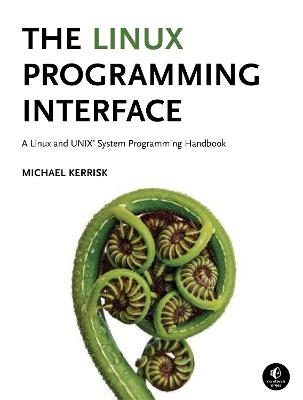
Linux Programming Interface
No Starch Press (Verlag)
978-1-59327-220-3 (ISBN)
The Linux Programming Interface is the definitive guide to the Linux and UNIX programming interface-the interface employed by nearly every application that runs on a Linux or UNIX system.
In this authoritative work, Linux programming expert Michael Kerrisk provides detailed descriptions of the system calls and library functions that you need in order to master the craft of system programming, and accompanies his explanations with clear, complete example programs.
You'll find descriptions of over 500 system calls and library functions, and more than 200 example programs, 88 tables, and 115 diagrams.
You'll learn how to:
- Read and write files efficiently
- Use signals, clocks, and timers
- Create processes and execute programs
- Write secure programs
- Write multithreaded programs using POSIX threads
- Build and use shared libraries
- Perform interprocess communication using pipes, message queues, shared memory, and semaphores
- Write network applications with the sockets API
While The Linux Programming Interface covers a wealth of Linux-specific features, including epoll, inotify, and the /proc file system, its emphasis on UNIX standards (POSIX.1-2001/SUSv3 and POSIX.1-2008/SUSv4) makes it equally valuable to programmers working on other UNIX platforms.
The Linux Programming Interface is the most comprehensive single-volume work on the Linux and UNIX programming interface, and a book that's destined to become a new classic.
Michael Kerrisk has been using and programming UNIX systems for more than 20 years, and has taught many week-long courses on UNIX system programming. Since 2004, he has maintained the "man-pages" project, which produces the manual pages describing the Linux kernel and "glibc" programming APIs. He has written or co-written more than 250 of the manual pages and is actively involved in the testing and design review of new Linux kernel-userspace interfaces. Michael lives with his family in Munich, Germany.
Preface
Chapter 1: History and Standards
Chapter 2: Fundamental Concepts
Chapter 3: System Programming Concepts
Chapter 4: File I/O: The Universal I/O Model
Chapter 5: File I/O: Further Details
Chapter 6: Processes
Chapter 7: Memory Allocation
Chapter 8: Users and Groups
Chapter 9: Process Credentials
Chapter 10: Time
Chapter 11: System Limits and Options
Chapter 12: System and Process Information
Chapter 13: File I/O Buffering
Chapter 14: File Systems
Chapter 15: File Attributes
Chapter 16: Extended Attributes
Chapter 17: Access Control Lists
Chapter 18: Directories and Links
Chapter 19: Monitoring File Events
Chapter 20: Signals: Fundamental Concepts
Chapter 21: Signals: Signal Handlers
Chapter 22: Signals: Advanced Features
Chapter 23: Timers and Sleeping
Chapter 24: Process Creation
Chapter 25: Process Termination
Chapter 26: Monitoring Child Processes
Chapter 27: Program Execution
Chapter 28: Process Creation and Program Execution in More Detail
Chapter 29: Threads: Introduction
Chapter 30: Threads: Thread Synchronization
Chapter 31: Threads: Thread Safety and Per-Thread Storage
Chapter 32: Threads: Thread Cancellation
Chapter 33: Threads: Further Details
Chapter 34: Process Groups, Sessions, and Job Control
Chapter 35: Process Priorities and Scheduling
Chapter 36: Process Resources
Chapter 37: Daemons
Chapter 38: Writing Secure Privileged Programs
Chapter 39: Capabilities
Chapter 40: Login Accounting
Chapter 41: Fundamentals of Shared Libraries
Chapter 42: Advanced Features of Shared Libraries
Chapter 43: Interprocess Communication Overview
Chapter 44: Pipes and FIFOs
Chapter 45: Introduction to System V IPC
Chapter 46: System V Message Queues
Chapter 47: System V Semaphores
Chapter 48: System V Shared Memory
Chapter 49: Memory Mappings
Chapter 50: Virtual Memory Operations
Chapter 51: Introduction to POSIX IPC
Chapter 52: POSIX Message Queues
Chapter 53: POSIX Semaphores
Chapter 54: POSIX Shared Memory
Chapter 55: File Locking
Chapter 56: Sockets: Introduction
Chapter 57: Sockets: UNIX Domain
Chapter 58: Sockets: Fundamentals of TCP/IP Networks
Chapter 59: Sockets: Internet Domains
Chapter 60: Sockets: Server Design
Chapter 61: Sockets: Advanced Topics
Chapter 62: Terminals
Chapter 63: Alternative I/O Models
Chapter 64: Pseudoterminals
Appendix A: Tracing System Calls
Appendix B: Parsing Command-Line Options
Appendix C: Casting the NULL Pointer
Appendix D: Kernel Configuration
Appendix E: Further Sources of Information
Appendix F: Solutions to Selected Exercises
If I had to choose a single book to sit next to my machine when writing software for Linux, this would be it.
Martin Landers, Software Engineer, Google
If you think you don't need this book since you know everything already, that's what I thought too, and I was wrong.
Bert Hubert, Netherlabs Computer Consulting
Michael Kerrisk's new book [is] a thing of beauty. A book you're proud to just have on the shelf, but too useful to stay there.
Serge Hallyn, Linux Kernel Developer
I found The Linux Programming Interface to be extremely useful and expect to return to it frequently. Anyone who has an interest in programming for Linux will likely feel the same way.
Jake Edge, LWN.net
... the most complete and up-to-date book about Linux and UNIX system programming. If you're new to Linux system programming, if you're a UNIX veteran focused on portability while interested in learning the Linux way, or if you're simply looking for an excellent reference about the Linux programming interface, then Michael Kerrisk's book is definitely the companion you want on your bookshelf.
Loïc Domaigné, Chief Software Architect (Embedded), Corpuls.com
What could be better than an encyclopedic reference to the Linux system, from the standpoint of the system programmer, written by none other than the maintainer of the man pages himself? The Linux Programming Interface is comprehensive and detailed. I firmly expect it to become an indispensable addition to my programming bookshelf.
Bill Gallmeister, Author of POSIX.4 Programmer's Guide: Programming for the Real World
... an essential resource for the serious or professional Linux and UNIX systems programmer. Michael Kerrisk covers the use of all the key APIs across both the Linux and UNIX system interfaces with clear descriptions and tutorial examples and stresses the importance and benefits of following standards such as the Single UNIX Specification and POSIX 1003.1.
Andrew Josey, Director, Standards, The Open Group, and Chair of The POSIX 1003.1 Working Group
I've been very impressed by the precision, the quality and the level of detail Michael Kerrisk put in his book. He is a great expert of Linux system calls and lets us share his knowledge and understanding of the Linux APIs.
Christophe Blaess, Author of Programmation système en C sous Linux
... encyclopedic in the breadth and depth of its coverage, and textbook-like in its wealth of worked examples and exercises. Each topic is clearly and comprehensively covered, from theory to hands-on working code. Professionals, students, educators, this is the Linux/UNIX reference that you have been waiting for.
Anthony Robins, Associate Professor of Computer Science, The University of Otago
... a very thorough—yet easy to read—explanation of UNIX system and network programming, with an emphasis on Linux systems. It's certainly a book I'd recommend to anybody wanting to get into UNIX programming (in general) or to experienced UNIX programmers wanting to know 'what's new' in the popular GNU/Linux system.
Fernando Gont, Network Security Researcher, IETF Participant, and RFC Author
Michael's inexhaustible determination to get his information right, and to express it clearly and concisely, has resulted in a strong reference source for programmers. While this work is targeted at Linux programmers, it will be of value to any programmer working in the UNIX/POSIX ecosystem.
David Butenhof, Author of Programming with POSIX Threads and Contributor to the POSIX and UNIX Standards
Michael Kerrisk has not only written a great book about Linux programming and how it relates to various standards, but has also taken care that bugs he noticed got fixed and the man pages were (greatly) improved. In all three ways, he has made Linux programming easier. The in-depth treatment of topics in The Linux Programming Interface . . . makes it a must-have reference for both new and experienced Linux programmers.
Andreas Jaeger, Program Manager, openSUSE, Novell
This book, with its detailed descriptions and examples, contains everything you need to understand the details and nuances of the low-level programming APIs in Linux ... no matter what the level of reader, there will be something to be learnt from this book.
Mel Gorman, Author of Understanding the Linux Virtual Memory Manager
Everything relating to the subject that I could reasonably think of is in the book, in a very thorough and maniacally complete yet enjoyably readable way.
Federico Lucifredi, Slashdot.org
| Zusatzinfo | black & white tables, figures |
|---|---|
| Verlagsort | Daly City, California |
| Sprache | englisch |
| Maße | 186 x 236 mm |
| Gewicht | 2326 g |
| Einbandart | kartoniert |
| Themenwelt | Informatik ► Betriebssysteme / Server ► Unix / Linux |
| Mathematik / Informatik ► Informatik ► Programmiersprachen / -werkzeuge | |
| Schlagworte | Linux • UNIX |
| ISBN-10 | 1-59327-220-0 / 1593272200 |
| ISBN-13 | 978-1-59327-220-3 / 9781593272203 |
| Zustand | Neuware |
| Haben Sie eine Frage zum Produkt? |
5 Derzeit das beste Buch zu diesem Themenbereich
von Törring Jens Thoms (Berlin), am 07.12.2010
Die Bandbreite der Themen, die in diesem Buch behandelt werden, ist nur als erstaunlich zu bezeichnen - das es über 1500 Seiten hat liegt ganz offensichtlich nicht daran, dass es dem Autor an einem kompetenten Lektor gemangelt hätte, sondern ergibt sich aus der extremen thematischen Breite, die allein schon seinen Preis rechtfertigt. Aber darüberhinaus werden alle diese verschiedensten Themen, soweit ich es gelesen habe, durchgehend prägnant, kompetent und vollständig abgehandelt. Egal, ob man sich mit einem der Themen bereits auskennt oder sich in ein neues einarbeiten möchte, lohnt sich die Lektüre des entsprechenden Kapitels.
Der Aufbau der 64 Kapitel, die man in der Regel ohne allzuviele Bezüge auf andere verstehen kann, besteht meist aus einer kurzen, grundsätzlichen Beschreibung des Problems, gefolgt von einer präzisen Diskussion der SystemFunktionen, die beim Schreiben eines Programms zur Verfügung stehen. Sofern es Unterschiede zu anderen UNIX-Versionen oder dem POSIX/SUS Standard gibt werden diese soweit wie notwendig diskutiert, so dass das Buch keineswegs nur für Linux-Programmierer von Bedeutung ist. Neben der Beschreibung der System-Funktionen findet man eine ausreichende Anzahl kurzer Beispielprogrammen, die die Verwendung der beschriebenen Funktionen demonstrieren und auf mögliche Probleme hinweisen. Abgeschlossen werden die Kapitel mit einem Satz von "Ŭbungsaufgaben" (für die weniger trivialen gibt es Lösungsvorschläge im Anhang).
Das letzte Mal, dass ich auf ein technisches Buch ähnlicher Qualität gestoßen bin, war vor mehr als einem Jahrzehnt, als ich "Advanced Programming in the UNIX Environment" von Richard Stevens "entdeckte". Wie dieses ist "The Linux Programming Interface" klar und prazise, gleichzeitig aber sehr gut lesbar geschrieben. Es scheut genausowenig davor zurück, dem Leser auch die notwendigen Details zu vermitteln, die man sonst allzu häufig nur schwer (z.B. nach mehrfacher Lektüre von 'man-pages') findet und versteht. Wenn ich Stevens APUE auch immer noch sehr schätze, so muss ich konstatieren, dass dieses Buch einen deutlich umfangreicheren thematischen Bereich abdeckt. Daneben ist die Entwicklung von UNIX in den 17 Jahren seit dem Erscheinen von APUE nicht stehengeblieben, was dazu geführt hat, dass "The Linux Programming Interface" Schwerpunkte auf heute aktuellere Themen setzen kann. Es stellt meiner Meinung nach einen würdigen Nachfolger des klassischen Buchs von Stevens dar, und es ist nicht zu erwarten, dass ein Buch ähnlicher Qualität zu diesem Thema so schnell wieder erscheinen wird.
aus dem Bereich




